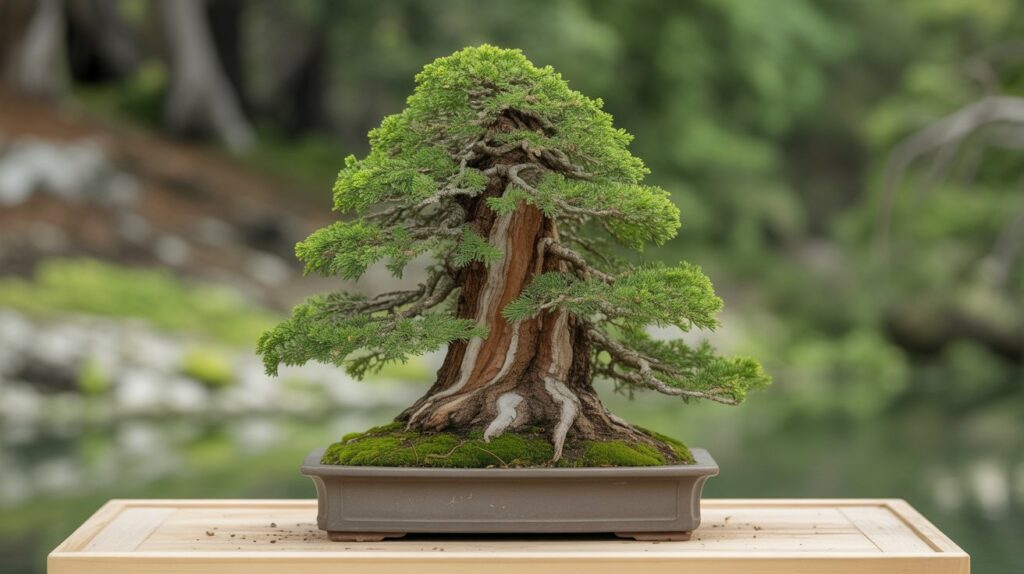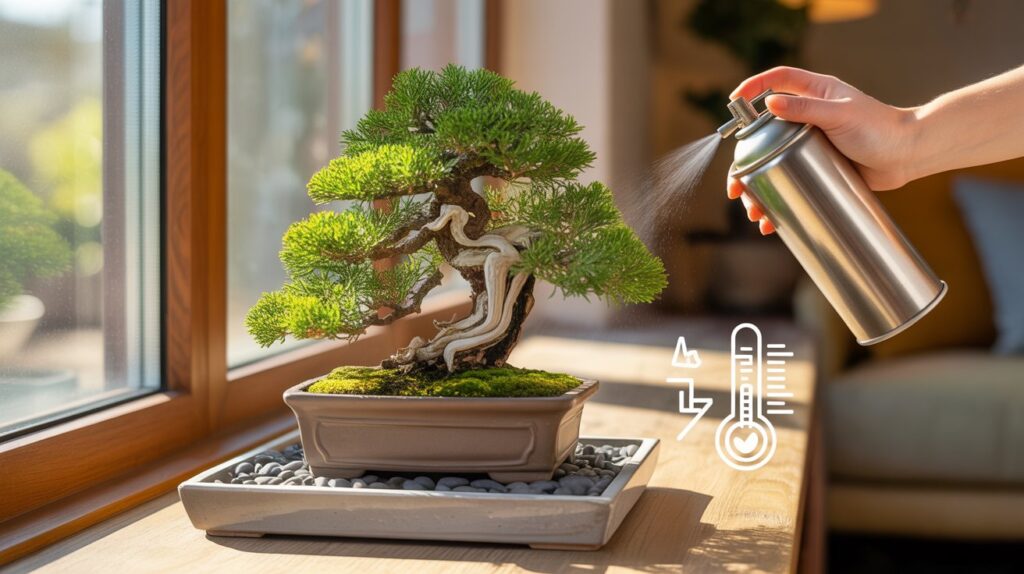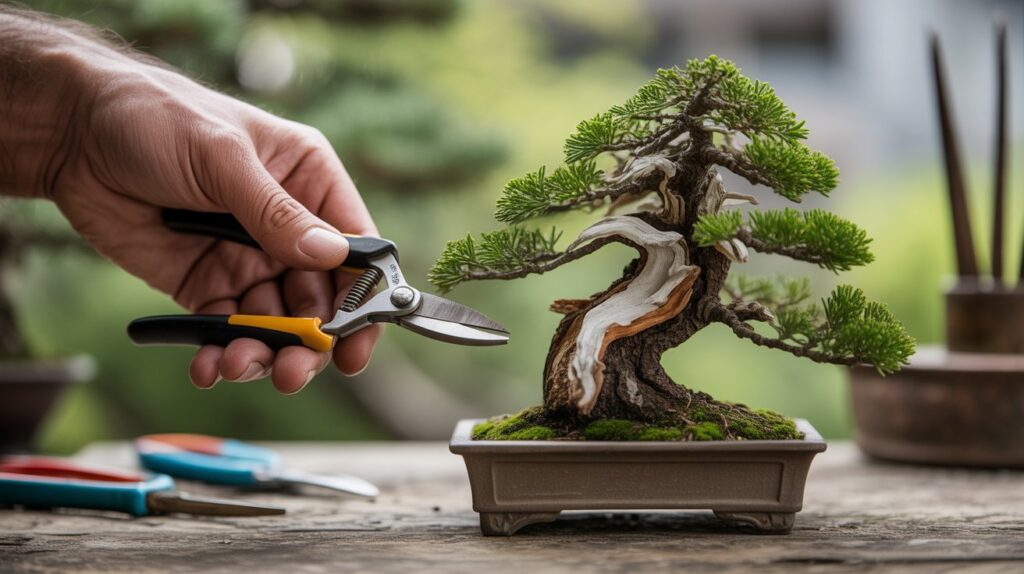
The Giant Sequoia Bonsai is a breathtaking tree to add to your bonsai collection and cultivate in miniature form. The Sequoia symbolizes strength and is known for its massive size in the wild, offering stunning visuals when transformed into a Sequoia Bonsai. If your interest lies in crafting a Sequoia Bonsai forest, cultivating indoor bonsai sequoia, or even nurturing Giant Sequoia Bonsai from seeds, this guide is for you.
The Sequoia Bonsai tree is a stunning representation of beauty and serenity, and like most bonsai, its cultivation does require a fair amount of patience and care. If you plan on getting a Sequoia Bonsai tree, I would recommend thoroughly reading this guide. It doesn’t matter if your ideal is getting a Giant Sequoia Redwood Bonsai or a Sequoia Giganteum Bonsai; this guide is here to help you.
What is a Sequoia Bonsai?
A Sequoia Bonsai is a miniature version of the majestic Sequoia tree, often grown as a Giant Sequoia Bonsai or Sequoia Giganteum Bonsai, prized for its towering form, lush foliage, and resilient nature.
With magnificent forms sometimes exceeding 300 feet in height, the Sequoia trees located in California and the Pacific Northwest do have towering forms. The Sequoia Bonsai tree, however, captivates with its compact form which manages to retain the character of the bigger ones.
The more famous ones are the Giant Sequoia Bonsai and Sequoia Giganteum Bonsai. Like all true bonsai, it is also a germinating tree from a seed and is famous among bonsai lovers because of its beauty and its fast, vigorous growth. All the Sequoia Bonsai are easy to identify by their needle-like leaves and thick, rugged, and fibrous bark, which is rough in texture and gives the tree an aged look.
Sequoia Bonsai are most easily cultivated in small containers, which require frequent pruning for proper care. They are easy to care for, which is a plus for any bonsai owner. Sequoia Bonsai trees are small cousins to the bigger versions, and each of them exudes magnificence and beauty, which all bonsai lovers would look for.
What Are the Different Types of Sequoia Bonsai Trees?
The most popular types of Sequoia Bonsai trees include Giant Sequoia Bonsai, Giant Sequoia Redwood Bonsai, and Sequoia Giganteum Bonsai. Each variety offers unique characteristics suited for different growing conditions.
When it comes to Sequoia Bonsai trees, there are a few key varieties that are commonly grown in bonsai collections. Let’s explore the main types:
Giant Sequoia Bonsai
It is the most popular variety of all. Due to the impressive viewing of these trees and their moderate growth rate, they are in demand. It’s defined by a massive trunk, its needle-like foliage, and a very thick and bushy canopy. It is true that this species can reach very large dimensions in the wild, but it is a true plus that as a bonsai it stays compact and easy to shape. It is possible that these trees can be grown both indoors as well as outdoors.
Giant Sequoia Redwood Bonsai
The Giant Sequoia Redwood Bonsai is a popular cultivar of the Giant Sequoia Bonsai that mirrors the full-grown Giant Sequoia tree. Its bright green leaves and sturdy trunk make the Giant Sequoia Redwood Bonsai a striking addition to any collection. This variety does well indoors, especially with the right care.
Sequoia Giganteum Bonsai
The Sequoia Giganteum Bonsai is valued not just for its beauty, but also for its resemblance to the robust bonsai sequoia trees. Known for its relatively fast growth pace, the Sequoia Giganteum Bonsai is a quick learner. With careful pruning and shaping, this variety can also be trained to remain small. Its striking beauty and unique qualities make it a favorite among enthusiasts.
Sequoia Bonsai Forest
The Sequoia Bonsai Forest is not a single variety, which is what makes it unique and special. This concept is a creative way to display multiple Giant Sequoia Bonsai trees. By planting several Giant Sequoia Bonsai Trees in a shallow container, cultivators can simulate the look of a natural Sequoia forest, achieving diverse heights and textures.
How to Grow a Sequoia Bonsai from Seeds
To cultivate a Giant Sequoia Bonsai from seeds, soak the seeds for 24 hours, place them in well-draining soil, and maintain warmth and humidity. The germination period spans several weeks.
Cultivating a Giant Sequoia Bonsai from seeds is a thrilling journey, albeit a lengthy one. Here’s the step-by-step guide to kickstart your journey:
Soak the Seeds
To begin, soak your Giant Sequoia Bonsai seeds in water for 24 hours. This process helps to soften the seed coat, which enhances germination.
Prepare the Soil
To keep your Sequoia Bonsai tree healthy, use a soil mix that contains akadama, pumice, and lava rock for proper drainage and to prevent overwatering.
Plant the Seeds
Following the soaking period, place the seeds into a shallow container filled with the soil mix. Cover the seeds gently, ensuring that the soil stays moist, but not overly saturated.
Build Heat and Humidity
Position the container in an area with high humidity and warm temperatures. An ideal temperature range is 65-75°F (18-24°C). For moisture retention, a humidity dome or plastic wrap can be handy.
Germination Wait Time
Entrusting life to the germination process is always a waiting game. In the event that germination is taking longer than a few weeks, patience is a virtue. Moving the seeds into separate pots is possible after your seeds have successfully sprouted.
Can You Grow a Giant Sequoia Bonsai Indoors?
Yes, Giant Sequoia Bonsai can be grown indoors with proper care. Ensure it receives ample sunlight, humidity, and regular watering to keep it healthy indoors.
While visitors are welcomed with the aesthetic beauty of trees like the Giant Sequoia Bonsai, the indoors, with the right circumstances, can also be transformed into a nurturing home. Focus on these points to successfully create a bonsai indoors:
Sunlight
The Genus Sequoiadendron Bonsai trees require as much light as possible to remain healthy. Placing the tree close to a window facing south will provide the plant with 4-6 hours of direct light. This is the baseline to keep the Giant Sequoia healthy.
Humidity
Indoor bonsai suffers from a lack of humidity and dry air, especially from the heater in the winter. For the Giant Sequoia Bonsai, a humidity tray or room humidifiers can be beneficial in keeping the right moisture levels.
Watering
For Sequoia Bonsai trees, consistency is key. Avoid overwatering and allow for proper drainage because the trees are sensitive to root rot. Proper watering will help dry bonsai thrive.
Temperature Control
For your Sequoia Bonsai, keep it in an area with a stable temperature. Avoid putting the bonsai next to windows that are heating or cooling, as they can stress the tree.
With a little attention to the basics described above, your Giant Sequoia Bonsai can flourish indoors, just like it would in the great outdoors.
What is the Best Soil for Sequoia Bonsai Trees?
Giant Sequoia Bonsai trees require a well-draining soil mix that includes akadama, pumice, and lava rock. This mix provides proper aeration and prevents root rot.
When it comes to planting and taking care of a Giant Sequoia Bonsai tree, choosing the right soil is crucial. These trees thrive in well-draining soil so the roots can absorb air and survive. Sequoia Bonsai trees do best with a mixture of akadama, pumice, and a little bit of lava rock, as it drains very well and does not retain water that would cause root rot.
The soil mix for Giant Sequoia Bonsai must have a pH level between 6 to 6.5 since it’s mildly acidic. This closely matches the environment where these trees grow. In addition, the soil must not retain water, as this can lead to the growth of fungus and damage the roots of the plant. Check the soil regularly and replace the mix every few years to ensure it remains in good condition.
How Do You Prune a Giant Sequoia Bonsai?
Pruning a Giant Sequoia Bonsai involves removing dead branches, cutting back new growth, and shaping the tree to maintain its miniature form. Prune during active growing seasons for optimal results.
Pruning is one of the most important aspects of caring for your Giant Sequoia Bonsai tree. It helps maintain the tree’s shape, encourages new growth, and keeps the tree healthy. Here’s a step-by-step guide to pruning your Sequoia Bonsai tree:
Remove Dead or Diseased Branches
Start with the basic step of removing the dead, infected, or broken branches. This step protects the tree from infections and helps it look neat and clean.
Trim Back New Growth
To keep a tree healthy and retain its natural shape, maintaining a balanced canopy and preventing a “leggy” tree, you need to remove any new growth that is out of shape or new growth that is too spindly.
Shape the Tree
With the Giant Sequoia Bonsai trees growing quickly, you need to shape them regularly. To guide growth effectively, cut with sharp, sterilized pruning shears that are clean.
Prune your Giant Sequoia Bonsai during the growing season, usually in late spring or early summer, to ensure the tree remains strong and healthy.
How do you create a Sequoia Bonsai forest?
To create a Sequoia Bonsai forest, you need multiple Giant Sequoia Bonsai trees. Each tree should be evenly spaced in a shallow pot. Prune the trees so they look natural, as if they are in a forest.
Building a Sequoia Bonsai forest is a striking way to display the grandeur of these trees on a smaller scale. Begin by choosing a few Giant Sequoia Bonsai trees of different heights. Place them in a wide, shallow container, ensuring adequate spacing in between to prevent root crowding. Some trees should be taller than others, as you mimic the dynamic structure of a real forest. Prune the trees regularly to maintain a natural, tiered growth pattern.
To further enrich the forest aesthetic, you can add decorative touches such as small rocks, moss, or even tiny figurines. Creating a Sequoia Bonsai forest will be an enjoyable challenge, as you will be able to experiment with different techniques, resulting in a striking harmony between the trees.
Conclusion
Cultivating a Giant Sequoia Bonsai tree from seed, regularly incorporating Giant Sequoia Bonsai pruning, maintaining the tree, or creating an impressive Sequoia Bonsai forest are all ways to harness a unique tree. The tree will bring serene beauty to your home or garden. Given the right amount of attention and care, the Sequoia Bonsai will flourish and serve as a captivating, mini version of the majestic Sequoia forests.
Bonsai cultivation is a rewarding hobby and a unique way to express creativity.
FAQs About Growing and Caring for Giant Sequoia Bonsai
Can I grow a Giant Sequoia Bonsai tree indoors?
Yes, Giant Sequoia Bonsai trees can be grown indoors. Providing at least 4-6 hours of direct natural sunlight is a must. Moreover, maintaining precise indoor humidity, along with proper soil drainage, is critical to the tree’s health. To keep indoor humidity, a humidity tray is useful, as is a room humidifier.
What is the best time to prune a Giant Sequoia Bonsai?
The best time to prune is during active growth in spring to early summer. Pruning at this time helps the Bonsai heal quickly and sprout new growth. Make sure to always use sharp, sterilized tools to prevent any infection.
How do I grow a Giant Sequoia Bonsai from seeds?
Germinating Giant Sequoia Bonsai seeds requires soaking them for 24 hours. After that, plant the seeds in well-draining soil. Providing a warm and humid environment is critical for successful germination, which can take several weeks. Once the seedlings are capable enough, transplant them individually to separate pots.
What soil is best for Giant Sequoia Bonsai trees?
Giant Sequoia Bonsai trees do best with a soil blend that drains water easily. A mixture of akadama, pumice, and lava rock works well. This mixture provides adequate aeration and drainage while also providing some nourishment. Do not include soil that retains more moisture, as that would increase the chances of root rot.
What are common pests and diseases that affect Giant Sequoia Bonsai trees?
Giant Sequoia Bonsai trees can be affected by pests such as aphids, scale insects, and spider mites. Foliage can suffer damage, and growth can be stunted. Also, diseases can form owing to insufficient drainage. Proper drainage and too much moisture can also lead to fungal problems. Periodically check your Sequoia Bonsai for pests, and use neem oil or insecticidal soap for treatment.



